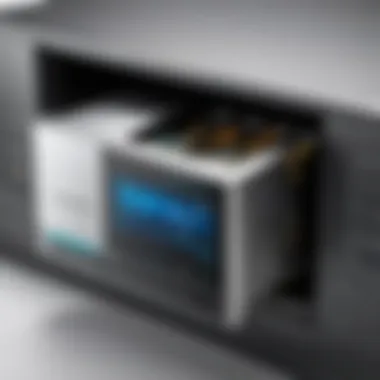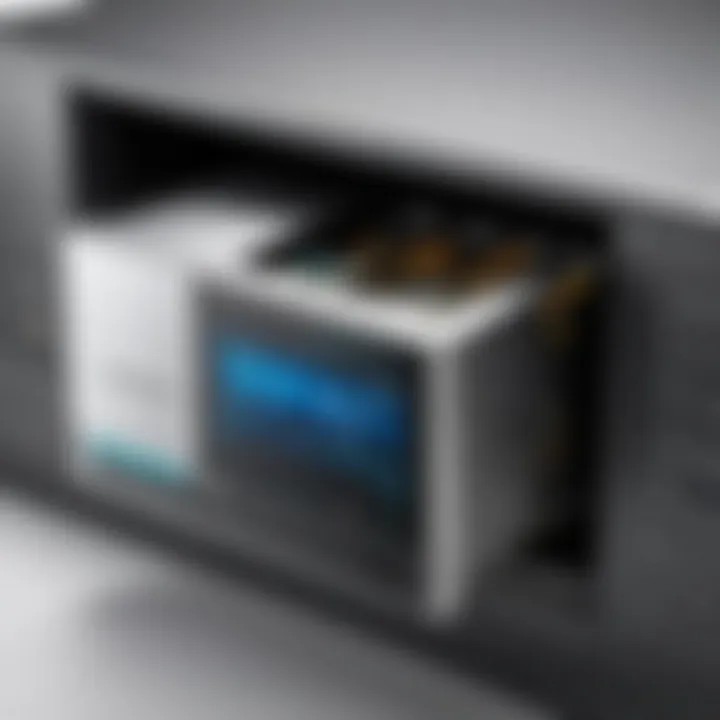Guide to Deleting Files from Carbonite Backup Storage


Intro
In today’s digital age, managing data effectively is vital, and backup systems like Carbonite provide a safety net against unexpected file loss. However, while ensuring everything is stored safely, users often need to take a step back and reassess what to keep and what to let go. Deleting files from your Carbonite backup might seem daunting at first glance—navigating the interface and understanding the implications can be tricky. But don't fret; this guide will serve as your compass, making this task straightforward and clear.
This discussion will not only break down the process into digestible parts but also shed light on some common pitfalls and best practices to keep in mind. We'll cover everything from the initial understanding of Carbonite’s interface to the nuances of permanent file deletion and effectively managing your storage space.
Software Overview
Key Features
Carbonite extends many features tailored towards seamless file management. Here’s a snapshot of what it offers:
- Automatic Backups: Carbonite runs backups automatically, ensuring your files are always protected.
- File Recovery Options: Lost a crucial document? Carbonite provides various recovery options to restore files.
- Mobile Access: You can access your files from mobile devices, adding an extra layer of convenience.
- Encryption: Your data is encrypted in transit and at rest, a crucial aspect for security.
System Requirements
Before diving into the deletion process, it's wise to ensure your system meets Carbonite's requirements:
- Operating Systems: Compatible with Windows and Mac OS, each with specific version requirements.
- Internet Connection: A stable internet connection is essential for backups and deletions to sync properly.
- Storage: Sufficient storage on your device to support the Carbonite software and its operations.
In-Depth Analysis
Performance and Usability
When assessing its performance, Carbonite shines with an intuitive interface that streamlines file management. Users often find its layout user-friendly, making the navigation to delete files a straightforward process. The backup speed is generally robust, allowing quick uploads while ensuring that managing deletions does not interrupt other tasks. It's also essential to keep the application updated to avoid compatibility issues, which can affect usability.
Best Use Cases
Understanding when to use Carbonite effectively can aid in optimizing your storage. Here are prime scenarios to consider:
- For Professionals: Anyone in IT, marketing, or content creation can benefit by securing essential documents that need to be accessed frequently.
- For Families: Households with multiple devices can back up personal files, photos, and projects, centralizing storage and access.
- For Students: Individuals managing assignments and coursework will find the automatic backup handy, ensuring no last-minute loss occurs before deadlines.
"Effective management of digital backups is as critical as the backups themselves, allowing users to reclaim space and maintain efficiency."
By understanding these aspects, users can not only enhance their backup experience but also ensure they maintain a clutter-free digital space.
Understanding Carbonite Backup
Navigating the complexities of data management today can feel like trying to find a needle in a haystack. With a myriad of backup solutions available, selecting the right one is crucial for maintaining your data integrity. Carbonite Backup stands out in this crowded field, thanks to its user-friendly interface and robust features.
What is Carbonite?
Carbonite is essentially an online backup service that automates the process of saving files to a secure cloud environment. It works quietly in the background, ensuring that your files are backed up regularly without requiring excessive user intervention. This is especially important for those who may not have the technical expertise to manage their own backups. For instance, if you’re a software developer working on critical projects, you don’t want to lose hours of hard work due to an unforeseen issue, and Carbonite offers a safety net.
Features of Carbonite Backup
The platform boasts several features that make it a preferred choice among users:
- Automatic Backups: With default settings, files are backed up automatically whenever changes are detected, saving you from the hassle of manual updates.
- Secure Storage: Data is encrypted during transfer and while at rest, which is vital for safeguarding sensitive information.
- Flexible Recovery Options: Users can choose to recover full backups or individual files, ensuring greater control over what gets restored after a loss.
- Mobile Access: Users can access their backed-up files through mobile devices, providing convenience for on-the-go access.
These features collectively simplify the often tedious process of data management, particularly when considering the potential for data loss.
Importance of File Management
Effective file management is not just about saving space; it is a pivotal aspect of efficient workflow. Understanding how to manage your files within Carbonite is key to maximizing the benefits of this service. Organizing files thoughtfully not only aids in retrieval but also addresses any performance issues tied to backup sizes.
Moreover, knowing how to delete unnecessary files from your backups frees up storage space, enhances backup performance, and ensures that your most pertinent files are front and center when you need them. As such, it’s crucial to get a grip on how the deletion process works in Carbonite, making your data management even more effective.
"The capacity to manage files effectively could mean the difference between an organized workspace and a chaotic disaster."


In summary, a solid understanding of what Carbonite offers and the importance of file management can lead to better decision-making, more efficient use of the platform, and ultimately, enhanced data security. Readers—especially those in software development, IT, and related fields—will find navigating Carbonite's features, including deleting files, beneficial for maintaining best practices in data management.
Initiating the Deletion Process
Initiating the deletion process is a key step in managing your Carbonite backup. It's that moment when you decide to clear out unwanted files and make use of storage space, which can often be limited. This process is not just about pressing a delete button; it’s about understanding what you are removing and how it impacts your overall data management. The benefits of being intentional about deleting files are numerous. It helps in optimizing your backup performance, ensuring that only necessary files occupy your allocated space. Plus, it can save you from unnecessary clutter when it comes to version history of backed-up files that may eventually become outdated.
When you initiate the deletion process, you're not just cleaning house; you are also making decisions that align with your ongoing need for accessibility and organization. Considerations include knowing the difference between temporary and permanent deletions, which we'll dive into shortly. Keeping files that are no longer useful can slow down searches and backups, while smart deletion practices can create a more efficient backup system.
Remember, careful management of your backup system can lead to significant improvements in efficiency and storage usage.
Accessing the Carbonite Dashboard
To start the deletion process, accessing the Carbonite dashboard is your first step. The dashboard serves as your control center where you can view all your backed-up files and settings. To reach it, simply launch the Carbonite application. If you're using the web version, navigate to the Carbonite website and log into your account.
Once inside, you’ll notice an organized layout where your files are categorized, making it easier to find what you want to delete. Arrays of options will also be available, so you can quickly access settings relevant to your backup needs. Familiarizing yourself with this interface is crucial because it lets you identify what you need to delete while also keeping an eye on what’s critical for your work or personal use.
Navigating the Backup Settings
After reaching the dashboard, the next move is to navigate to the backup settings. This section enables you to customize how Carbonite operates regarding your files. You'll typically find options like file selection, backup frequency, and storage space allocation.
In the backup settings, it’s important to do a little homework. Review which files are backed up and make decisions about what should stay and what should go. For instance, you may see files that haven’t been accessed in ages; perhaps it's time to let them go.
When deleting files, being aware of their current status is key; some may be critical for projects or may have versions you hadn’t considered.
Here’s a list of what to look for while navigating:
- Backup frequency settings: Adjust how often backups occur, ensuring you are not storing outdated files.
- File selection: Identify which files are important and which can be removed.
- Storage overview: Look at your storage space usage to understand what impact deleting certain files can have.
In summary, taking the time to understand both the dashboard and backup settings can set the stage for a smooth deletion process, making it all the more efficient.
Locating Files for Deletion
Identifying the files you want to delete from your Carbonite backup is a crucial step in managing your storage effectively. When you know exactly what you're dealing with, it prevents unnecessary confusion and ultimately aids in precise data management. Accidental deletions can throw a wrench into your carefully organized digital life, so here, we’ll focus on how to navigate this process with clarity.
Viewing Backup Files
To begin, let’s dive into how to actually view the files backed up on Carbonite. The Carbonite dashboard serves as your command center. Once you are logged in, the left sidebar usually exhibits various features including a section labeled Backup. Clicking on this will reveal a comprehensive list of all your backed-up files organized by folders.
"A little clarity can go a long way in avoiding chaos down the road."
- Structured Layout: The importance of having a structured layout cannot be overstated. Carbonite arranges files in a way that mimics their original filing system. This makes it much easier to locate specific files without excessive searching.
- Sorting Options: Utilize sorting options by date, file type, or folder name to fine-tune your view and locate files more quickly. Not only does this save time, but it also reduces frustration.
After you’ve found the right folder, take your time to browse through the contents. Ensure that you fully understand what files are backed up. Remember, some files may be essential; understanding this will guide your deletion choices later.
Searching for Specific Files
If you're not up for sifting through folders one by one, the search functionality can be a godsend. Carbonite has a search bar typically located at the top of the dashboard that allows you to quickly locate files, even if you’re not sure where they are stored.
- Keywords: Type in keywords or file names to narrow down your search. Carbonite will filter the results, showing relevant matches that can save you a lot of time.
- File Types: Additionally, considering file types can expedite your search. You might have thousands of documents but only a handful of images; knowing this can be a shortcut to locating what you need.
In essence, being adept at locating files for deletion lays the groundwork for effective file management. Not only does it enhance your overall experience using Carbonite, but it also ensures that your essential files retain their accessibility and integrity. Understanding how to view and search for files will empower you to make informed decisions regarding your backups, minimizing the chances of costly mistakes.
Deleting Files Safely
Deleting files from your Carbonite backup is not merely a click away; it is an action that deserves thoughtful consideration. This process is significant in managing storage space and ensuring that your data remains organized. Let’s dive into the aspects that make deleting files safely a vital part of using any backup solution.
One key consideration is the notion of data retention. In the hustle and bustle of managing digital belongings, it’s easy to overlook what files are essential. Deleting unnecessary files can free up space for more pertinent data, but it can also present a risk if you accidentally wipe something important. This reminds us that being deliberate about what we are removing is paramount.
Moreover, distinguishing between temporary and permanent deletion helps illuminate the safety aspect. Many backup solutions, including Carbonite, allow for temporary files to be recoverable. This feature can serve as extra peace of mind when you are cleaning house. Knowing the difference can lighten the load of that finger hovering above the delete button.
In effect, the approach taken for deleting files affects not just storage but your overall backup strategy.


Temporary vs Permanent Deletion
Temporary deletion functions like a safety net of sorts. Imagine you are cleaning your closet; throwing out a shirt you wore once might be a good call, but you might regret tossing that limited edition band t-shirt. In Carbonite, the concept is similar. It's designed to allow recovery of files that were deleted by mistake—at least temporarily. This gives you the chance to reconsider your choices before the final cut.
Permanent deletion, on the other hand, is akin to hitting the reset button. When files are permanently removed, they’re getting kicked unceremoniously to the curb with no return ticket. This might be appropriate for outdated or irrelevant files, but always think twice!
Using the Delete Function
Utilizing the delete function in Carbonite is rather straightforward. You simply need to:
- Open the Carbonite application or dashboard.
- Navigate to the files you wish to delete.
- Select the file(s) in question.
- Click the delete button.
It’s essential to grasp that pressing the delete button does far more than make something disappear. It’s the enactment of a decision to manage data effectively—ensure you’ve chosen wisely!
Confirmation and Final Steps
Once you’ve hit delete, you’re often greeted with a confirmation dialogue. This step serves a critical purpose. It’s your final chance to either confirm your choice or graciously backtrack.
After confirmation, it’s also helpful to double-check your storage overview. Look at your remaining space and make sure that the deletion took effect as intended.
As you navigate through these steps, remember: file management is not just about deleting but about shaping a digital landscape that works for you. Using the delete function wisely keeps your backup organized, efficient, and tailored just right for your needs.
Managing Deleted Files
Managing deleted files in Carbonite is more than just a simple task of pressing the delete button. It's a process that intertwines several important aspects of data management and storage efficiency. As you work through the various stages of backing up and deleting your files, it becomes essential to understand the ramifications of what happens to your storage once files are removed, and to also ensure you're equipped to recover anything important that may have been mistakenly deleted.
Understanding Storage Impact
When you delete files from your Carbonite backup, the immediate thought may be about freeing up space, but there’s a bit more to chew on. First off, it’s crucial to grasp how deletion impacts your storage. When files are pulled from the backup, they no longer take up space on Carbonite’s servers, which could lead to increased utilization of your chosen backup plan. This is especially relevant if you are operating under a limited storage capacity plan.
This removal can generate more room for new data, and it's essential to be proactive about what you really need backed up. Moreover, consider that the backup service may still take time to reflect these deletions, due to syncing processes.
In some cases, deleting files locally while they are still backed up online can create confusion or complicate scenarios too. Being clear about which files are truly necessary can not only make your backup more efficient but also enhance your system’s overall performance. Being organized means having a clearer view, ultimately reducing unnecessary clutter in your backup and ensuring that any real data loss can be addressed swiftly.
Recovering Deleted Files
Despite our best efforts in organizing and managing files, mistakes do happen. Understanding the process for recovering deleted files in Carbonite can serve as a safety net for those moments of uncertainty. Carbonite provides users with recovery options that can help restore lost data from recently deleted backups, helping you regain control over essential files.
To recover deleted files effectively, follow these steps:
- Access the Carbonite Dashboard: Start by logging into your account through the Carbonite web portal or application.
- Go to the Deleted Files Section: Look for the section designated for deleted files where Carbonite can keep a cache for retrieval.
- Select the Files You Want Back: Here, you can sift through what you’ve deleted, so knowing the exact file names or types can speed up this process.
- Initiate Restoration: Once identified, it’s as simple as clicking restore, and with a few confirmations, you should see those files return to your backup.
"It's a good practice to routinely check the deleted files section. If you do this, it maximizes your chances of recovering something before it’s too late."
Regular checks can save a lot of heartache later when you realize important data has gone missing. Furthermore, it's worth noting that only deleted files within a certain period may be recoverable; after that, they’re typically gone for good. This timeframe, often a few versions back, can depend on your specific backup settings.
In summary, managing deleted files effectively in Carbonite is not just about deletion; it’s about understanding how to fine-tune your backup as needed. Keep the structure nimble, always have your recovery options at the forefront, and don't let the chaos of unnecessary files create confusion. A balanced approach will keep your backup situation agile and in line with your storage goals.
Troubleshooting Common Issues
When navigating through the process of deleting files from Carbonite Backup, one may encounter various issues that impede progress. It's crucial to understand common problems and their solutions. Mastering troubleshooting can save significant frustration and time. Knowing how to diagnose and rectify these issues can empower users to manage their data more effectively, ensuring they don't stand at the edge of a digital cliff, unsure of how to proceed.
Files Not Deleting
A frustrating situation arises when files simply refuse to leave your backup. Often, this can be attributed to several underlying reasons. First, it’s important to check if the files are currently in use. If they're open in another program, Carbonite may prevent deletion. Closing those applications can often resolve this issue.
Another common reason is a minor glitch in the software. Restarting the Carbonite app might refresh its functionality. If the problem persists, checking for any updates to the software is wise. An outdated application can introduce bugs that hinder typical operations.
Keep in mind that some files could be marked as 'protected', which prevents deletion unless you change their status within the dashboard. To adjust this, navigate to the file's properties in your Carbonite account and look for options about protection settings.


Sync Conflicts
Sync conflicts present a different kind of hurdle. This happens when a file modification occurs simultaneously on different devices. If one device updates the file while another is still syncing, Carbonite can become confused as to which version is the true one, resulting in a conflict. The outcome could be that the system refuses to delete or modify the file.
To resolve these conflicts, consider the following steps:
- Identify the Conflict: Carbonite usually provides a notification about which file has a conflict.
- Review File Versions: Check both versions of the file and determine which one you wish to keep.
- Manually Sync: On conflicting devices, manually sync files to ensure they are aligned before attempting to delete.
It’s good practice to establish a routine for managing file edits across devices, ensuring that changes are synchronized adequately before deletion operations.
Contacting Customer Support
If reaching an impasse in resolving issues, contacting Carbonite's customer support can be a lifesaver. Their support team often holds the keys to issues that average users may overlook. When reaching out for help, here are a few tips:
- Be Specific: Clearly describe the issue you’re encountering. Mention the exact steps you took leading up to the problem.
- Screenshots: If viable, include screenshots. A visual can often expedite assistance.
- Have Your Credentials Ready: Support may need to verify your account to provide accurate help. Keeping account information handy can speed up the process.
Remember, Carbonite aims to assist users in getting the most out of their backup experience. Their support channels are there to help you navigate through complexities like a breeze.
"Troubleshooting is not about fostering a sense of helplessness; it’s about leveraging resources to wrestle back control of your data."
Armed with this insight, you're now better equipped to tackle common troubleshooting issues with Carbonite. Understanding these elements will not only enhance your experience but also ensure you skillfully manage your digital space.
Best Practices for File Management
When dealing with a tool like Carbonite, effective file management is paramount. It’s not merely about having a backup; it’s about having an organized, accessible, and efficient backup that works for you. Good practices ensure that important files are easy to find and that storage space is utilized wisely, preventing unnecessary clutter and potential confusion.
Regular Backup Reviews
Conducting regular reviews of your backups can be the difference between staying organized and losing valuable data. This practice is all about keeping tabs on what you have stored and identifying any unnecessary files that don’t need to take up space anymore. The process can be as simple as setting a reminder on your calendar each month to log into your Carbonite account and assess your backup.
Some beneficial outcomes of regular reviews include:
- Identifying Redundant Files: Often, multiple versions of a file can end up stored unnecessarily. Reviewing allows for elimination, freeing up valuable storage.
- Evaluating Importance: As time rolls on, some files lose relevance. A review helps prioritize what still needs backup and what can be deleted.
- Adjusting Backup Plans: Changes in work or study projects might alter your backup needs. Regular assessment ensures you’re not backing up outdated files while leaving new ones exposed.
Organizing Files Effectively
Organizing your files plays a crucial role in not only the efficiency of backups but also in the ease of accessing information when needed. A well-structured folder system can significantly cut down the time you spend searching for files. Here are some strategies for effective organization:
- Clear Naming Conventions: Use descriptive names for your files and folders. Instead of a vague title like "Document1", try something more informative like "Project_Proposal_Q4_2023".
- Thematic Grouping: Group similar files together. For instance, creating separate folders for different projects, departments, or subjects helps in quick retrieval.
- Consistent Structure: Maintain consistency across your organization system. If you create subfolders for a project, do this for every other project as well to ensure uniformity and ease of navigation.
Updating Backup Settings
As your work and storage needs evolve, so too should your backup settings in Carbonite. Regularly updating these settings is vital to ensure that all your necessary files are backed up while irrelevant ones are not. This process can help to avoid unnecessarily high storage usage which in turn can lead to higher costs.
Consider these actions for updating backups:
- Review Selected Folders: Make sure that the folders set to back up currently reflect your needs. If you’ve stopped working on a certain project, unselect that folder from your backup options.
- Utilize Scheduling Features: Carbonite allows for flexible scheduling of backups. Setting a daily or weekly schedule can help ensure that new files are regularly backed up without manual effort.
- Regular Notifications: Enable notifications for better awareness. Carbonite can notify you about backup statuses and any interruptions, allowing for quick action if issues arise.
"A stitch in time saves nine." The notion holds true in file management—keeping your backup strategy up to date will save you headaches later on.
Ultimately, adopting these best practices ensures that you're not just backing up files but doing so in a way that enhances productivity while safeguarding against potential data loss.
Culmination
Cleaning up your Carbonite backup is not just about picking and deleting files. It embodies a holistic approach to managing your digital assets, ensuring you only retain what's truly important. Doing so can lead to significant benefits like saving storage space, decreasing the time taken for backups, and minimizing the clutter that often accumulates over time.
Recap of Deletion Process
In this guide, we’ve navigated through the entire process of deleting files from Carbonite effectively. From accessing the dashboard to finding specific files to delete, each step plays a pivotal role. Remember the importance of differentiating between temporary and permanent deletion. This choice impacts how you manage your files in future backups. Maintaining an organized backup not only streamlines your workflow but also makes it easier to find files in critical moments. In essence, a tidier digital library leads to swifter navigation and increased efficiency.
Encouragement for Informed Management
As you embark on the journey of file management with Carbonite, keep in mind that knowledge is power. Regularly review your backups and adjust your settings to align with any changes in your data needs. Take a proactive stance—this means being aware of what you need stored versus what can go. Don't shy away from the delete button when it's warranted. Every little cleanup effort counts. Embrace informed management practices to not only optimize your storage but also to foster a culture of mindfulness about your digital footprint.
"An ounce of prevention is worth a pound of cure."
With that wisdom in mind, take the reins of your backup management. Your future self will thank you for it.







